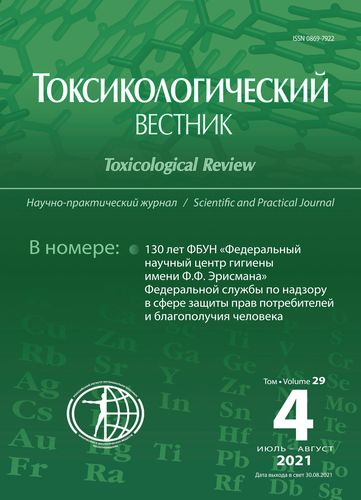Analysis of banned or severely restricted chemicals and pesticides entering the Russian market under the Rotterdam Convention on the prior informed consent procedure for certain hazardous chemicals and pesticides in international trade
- Authors: Khamidulina K.K.1,2, Tarasova E.V.1, Proskurina A.S.1,2, Guseva E.A.3
-
Affiliations:
- Russian Register of Potentially Hazardous Chemical and Biological Substances - Branch of F.F. Erisman Federal Scientific Hygiene Center, Rospotrebnadzor
- Russian Medical Academy of Continuous Professional Education, RF Ministry of Health
- I.M. Sechenov First Moscow State Medical University
- Issue: No 4 (2021)
- Pages: 30-39
- Section: Original articles
- Published: 03.09.2021
- URL: https://rjsocmed.com/0869-7922/article/view/641333
- DOI: https://doi.org/10.36946/0869-7922-2021-29-4-30-39
- ID: 641333
Cite item
Full Text
Abstract
Introduction. In recent years, due to the stricter requirements for compliance with the provisions of the Rotterdam Convention, the volume of export notifications on the permission to import dangerous chemicals into the Russian Federation has increased significantly. Therefore, the purpose of our research was to analyze the nomenclature, volume, toxicity and danger of industrial chemicals and pesticides entering the Russian market, despite prohibitions or restrictions on their use at the international and national levels.
Material and methods. The materials used are applications for the import of chemical products (export notifications) of the National Designated authorities of the European Union, China, Great Britain,
Serbia to the Russian Register of Potentially Hazardous Chemical and Biological Substances — a branch of F.F. Erisman Federal Scientific Center of Hygiene – in the period from 2018 to 2020. The year 2019 was considered in the most detail.
Results and discussion. The analysis of applications showed an ever-increasing number of chemical supplies; for example, 130 notifications were received in 2018, 539 in 2019, and 565 in 2020.
In 2019, the number of tin compounds prevailed in the nomenclature of imported products to the territory of the Russian Federation. As for the substances from Annex III of the Rotterdam Convention, most of the imported chemicals by tonnage were substances included in this document — 1,2-dibromoethane (EDB), carbofuran, ethylene oxide, ethylene dichloride (1,2-dichloroethane), which are imported for industrial use, and not for use as pesticides, as they are declared in the convention.
Chemicals and pesticides imported into the country under the PIC procedure, with the exception of numerous derivatives of dibutyl - and dioctyltin, creosote, have an established hygienic standard in at least one human habitat. In most cases, they are assigned to hazard classes 1 and 2 according to the maximum allowable concentration.
Conclusion. Chemical products that are highly dangerous for human health and the environment, which are banned or severely restricted in many states, caused specific and long-term effects on the body, and having high toxicity to natural biota are used in the Russian Federation economy. In this regard, there is a need to develop regulatory decisions at the national level and within the framework of the Eurasian Economic Commission on the prohibition or restriction of the circulation of substances and pesticides characterized by an unacceptable risk of exposure.
About the authors
Khalidya Kh. Khamidulina
Russian Register of Potentially Hazardous Chemical and Biological Substances - Branch of F.F. Erisman Federal Scientific Hygiene Center, Rospotrebnadzor; Russian Medical Academy of Continuous Professional Education, RF Ministry of Health
Author for correspondence.
Email: director@rosreg.info
ORCID iD: 0000-0001-7319-5337
Доктор медицинских наук; директор филиала РПОХБВ ФБУН ФНЦГ им. Ф.Ф. Эрисмана Роспотребнадзора; профессор, заведующий кафедрой гигиены ФГБОУ ДПО РМАНПО Минздрава России, г. Москва.
e-mail: director@rosreg.info
Russian FederationElena V. Tarasova
Russian Register of Potentially Hazardous Chemical and Biological Substances - Branch of F.F. Erisman Federal Scientific Hygiene Center, Rospotrebnadzor
Email: noemail@neicon.ru
ORCID iD: 0000-0002-4020-3123
Кандидат химических наук, химик-эксперт филиала РПОХБВ ФБУН ФНЦГ им. Ф.Ф. Эрисмана Роспотребнадзора, г. Москва.
e-mail: secretary@rosreg.info
Russian FederationAngelina S. Proskurina
Russian Register of Potentially Hazardous Chemical and Biological Substances - Branch of F.F. Erisman Federal Scientific Hygiene Center, Rospotrebnadzor; Russian Medical Academy of Continuous Professional Education, RF Ministry of Health
Email: proskurina-as@rosreg.info
ORCID iD: 0000-0003-2124-6440
Doctor in sanitary and hygienic laboratory research of the branch of F.F. Erisman Federal Scientific Hygiene Center, Rospotrebnadzor, 121087, Moscow, Russian Federation, Assistant of the Department of Hygiene, Russian Medical Academy of Continuous Professional Education, RF Ministry of Health, 125993, Moscow, Russian Federation.
e-mail: proskurina-as@rosreg.info
Russian FederationEkaterina A. Guseva
I.M. Sechenov First Moscow State Medical University
Email: guseva_e_a@staff.sechenov.ru
ORCID iD: 0000-0001-8389-7981
Ассистент кафедры экологии человека и гигиены окружающей среды Института общественного здоровья им. Ф.Ф. Эрисмана Первого Московского государственного медицинского университета им. И.М. Сеченова, г. Москва.
e-mail: guseva_e_a@staff.sechenov.ru
Russian FederationReferences
- Rotterdam Convention on the Prior Informed Consent Procedure for Certain Hazardous Chemicals and Pesticides in International Trade. UNEP, CHEMICALS, 2017. [Electronic resource]. URL: https://pic.int/ (accessed 15.04.2021).
- Federal Register of potentially hazardous chemical and biological substances. [Electronic resource]. URL: https://www.rpohv.ru/online/ (accessed 15.04.2021). (in Russian)
- IARC Monographs on the evaluation of carcinogenic risks to humans. [Electronic access]. URL: https://www.iarc.who.int/ (accessed 15.04.2021). (in Russian)
- Global Information Portal of the Organization for Economic Cooperation and Development (OECD) about the properties of eChemPortal chemicals. [Electronic resource]. URL: https://www.echemportal.org/echemportal/index.action (accessed 15.04.2021). (in Russian)
- SanPiN 1.2.3685-21. Hygienic standards and requirements for ensuring the safety and (or) harmlessness of environmental factors for humans. Sanitary and epidemiological rules and regulations (approved by the resolution of the Chief State Doctor of the Russian Federation of 28.01.2021 N 2). (in Russian)
- State catalog of pesticides and agrochemicals allowed for use in the territory of the Russian Federation. [Electronic resource]. URL: https://mcx.gov.ru/ (accessed 15.04.2021). (in Russian)
Supplementary files









